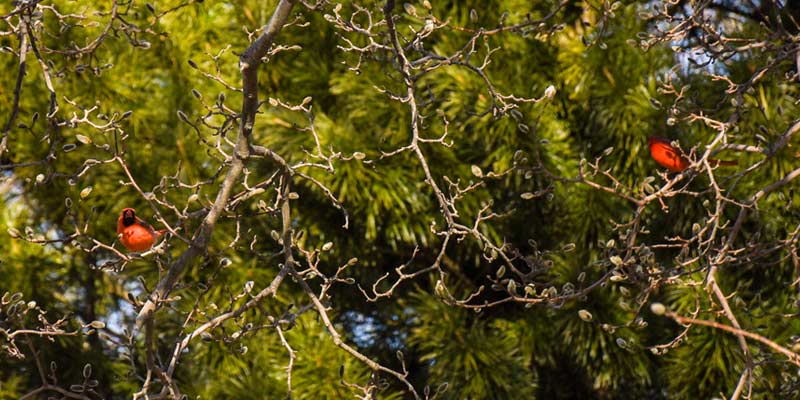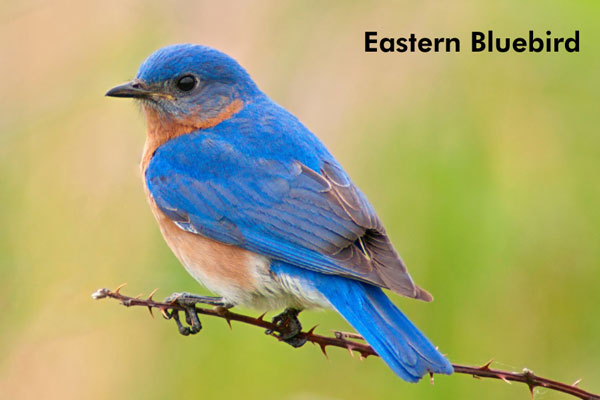Backyard Birds

There are about 10,000 species of birds on the planet making them one of the most diverse animal groups. Birds can be as small as the Bee Hummingbird or as large as an ostrich which is 9 feet tall and weighs over 300 pounds. Some birds fly while others can swim or run. Birds come in all shapes and sizes with endless adaptations to match their environment.
Flight and Feathers
Birds are the only animals that have feathers, and each individual has multiple different types of feathers. Depending on the species, the three most colorful and prominent feathers are wing feathers, tail feathers, and contour feathers. Wing feathers are the outermost feathers, and they are shaped to help birds fly. Tail feathers are found at the rear of the bird and help the bird to steer while flying. Contour feathers cover the rest of the bird’s body. Semiplume and down feathers are located closer to the bird’s body and are in charge of keeping the bird warm. Filoplumes are small, thin feathers that help to position contour feathers, and lastly, bristle feathers are found on the bird’s head to protect the face and eyes.
Each feather is attached to a muscle which allows birds to move them as needed. The bird can move the feathers together or apart to allow air to be blocked or pass through. Most birds have different flying abilities depending on their feathers and wing length. Some birds flap quickly like the hummingbird, while others move with long, slow strokes like blue herons. Some birds like buzzards just enjoy gliding on wind currents rather than flapping constantly.
Beak and Bills
The beaks of birds provide signs of what food the species likes to eat. Take a moment and think about different types of beaks that you have seen. Have you seen any that are sharp, rounded, short, or long? Birds that eat seeds, like sparrows, have short, strong, triangular beaks. Woodpeckers, however, have long, strong beaks with a point to drill into trees and find grubs under the bark. Owls, eagles, and hawks are birds of prey with strong, sharp beaks that allow them to tear off small pieces of meat. Ducks and flamingoes have bills that filter food from the water using the comb-like edges of their beaks. In your own time, research and compare the beak of a bird that lives on land and one that lives by the water.
Level-up! Bird beaks were the first animal adaptations that helped us to understand evolution and how different species came to be. A biologist, named Charles Darwin, studied the various beak shapes of finch species on the Galapagos Islands in the 1830s. His observations lead to the understanding that each beak was adapted to what the bird ate whether it be small or large seeds. Research Darwin’s findings to learn about the beak structures, diet, and habitat of the finch species on each island. Write down the information and discuss how environmental factors impact evolution.
Birding at the Garden
With our mixture of habitats here at New England Botanic Garden, many different species can be found while walking our trails. We find song sparrows and American goldfinches in our meadows and parking lot. Pileated woodpeckers can be heard or seen in our forests. The red-winged blackbirds’ favorite spot is down at the wildlife pond where they are easily spotted swooping overhead in the spring. Eastern bluebirds, cedar waxwings, and turkeys can usually be spotted throughout the Garden eating berries on shrubs.
These birds and many more can be found not only at the Garden but throughout central Massachusetts and maybe even in your backyard!
Activity
Build like a bird! Create your own nest using natural materials or craft materials found in your home.
Materials: cardboard, yarn, felt, string, feathers, pom poms, glue, sticks, straw
- Cut out a cardboard circle to act as the base of your nest.
- Make strips of cardboard and felt and cut short pieces of string to create the materials for the nest or collect natural materials like sticks, straw, and other things you find outside.
- Squeeze out glue along the edge of the cardboard circle.
- Layer the natural and/or craft materials in any order along the edge by stacking and gluing them. Buildup the edges while leaving the center empty.
- Once you are finished constructing the outside edges of the nest, glue down some feathers in the center to add something soft to rest on.
- Add in bird eggs to your nest using pom poms, playdough, mini pinecones, etc. as the eggs. Research the colors of different bird eggs and craft an egg that matches that color. For example, use blue eggs if you would like to make a robin’s nest.
Nature Exploration
Visit the Garden or head outside to your local park to go birding. Bring a journal, a birding field guide (local libraries rent these out), and a pair of binoculars if you have them. Take some time to search for types of native birds you are likely to find before you head out on your bird watching adventure. Listen to some songs of these native species before you leave and while you’re on the go by downloading Cornell Lab’s free Merlin Bird ID or visit AllAboutBirds.org to play sounds from your phone to help identify the species.
On your exploration, observe and answer some of the questions below:
- What does the bird’s song sound like?
- What color is the bird, and why might it be this color?
- Is it male or female? (Hint: males are usually more colorful)
- What does the bird’s beak tell you about what the bird eats?
- Observe a bird for 30 seconds and pay attention to their activity. What did you notice? Why do you think it was doing this? Take notes in a journal of what you notice.
Books and Resources
Look Up! Bird-Watching in Your Own Backyard by Annette LeBlanc Cate
Feathers Not Just for Flying by Melissa Stewart
All About Feathers
Backyard Birds
Birds of a Feather









